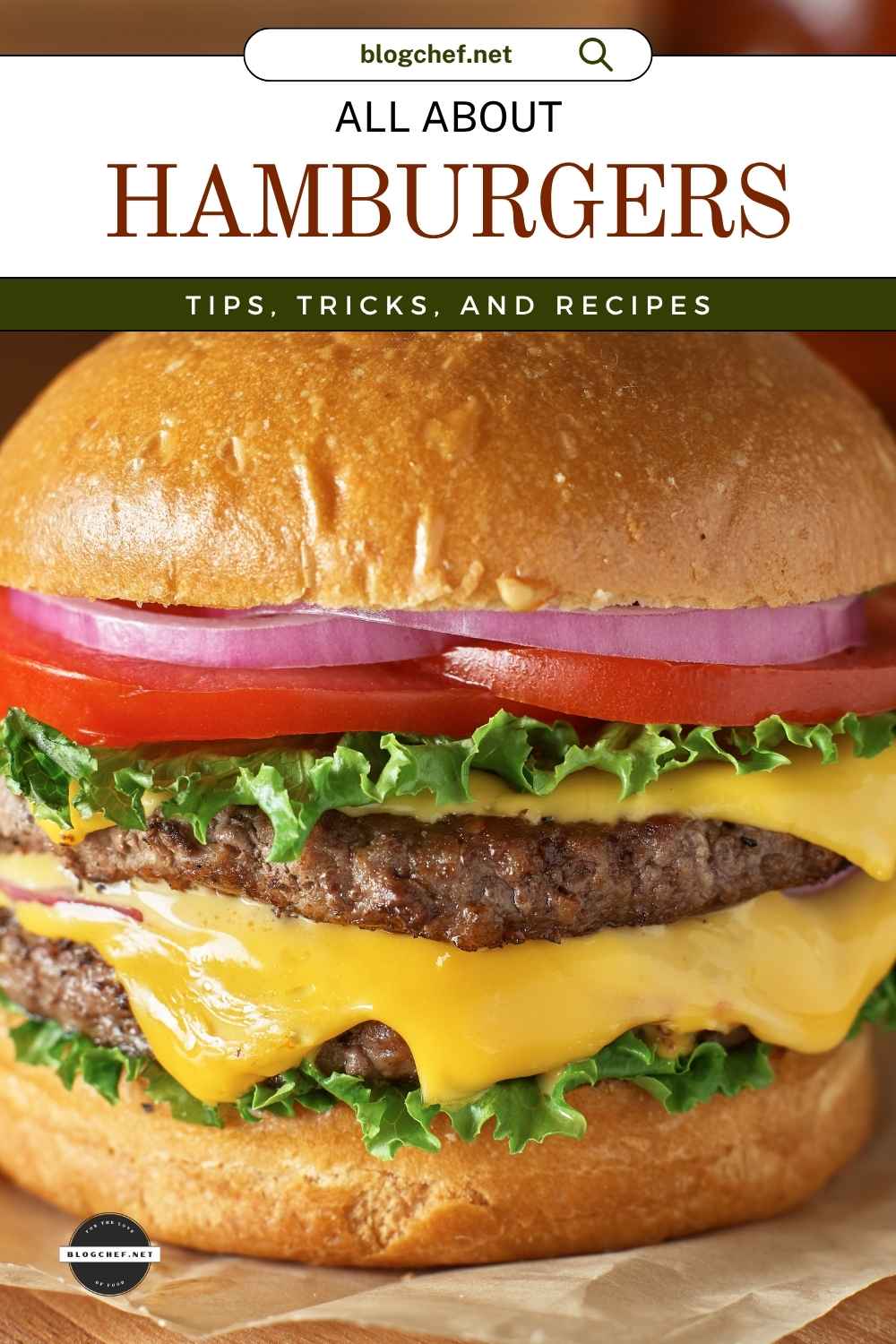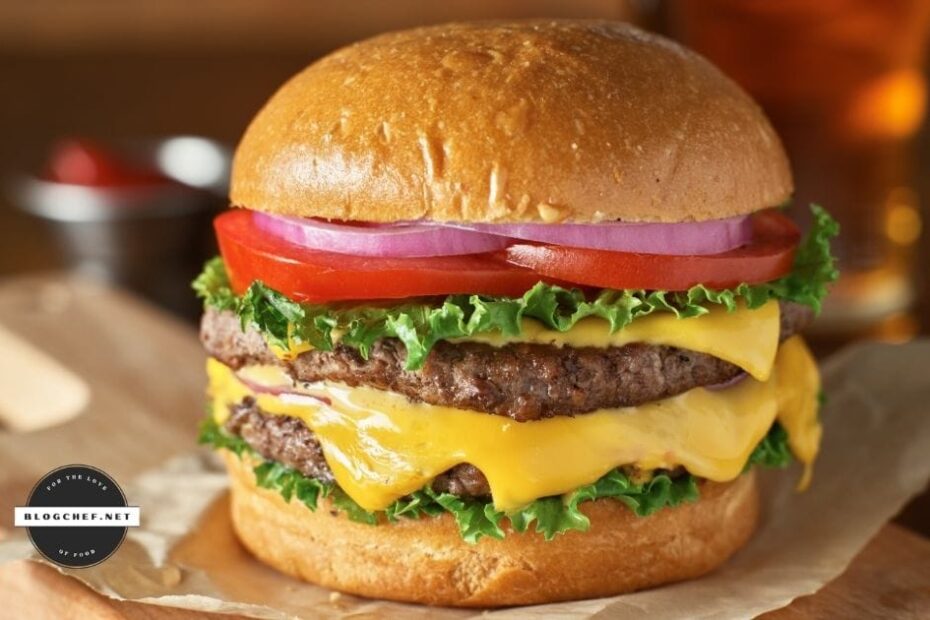Hamburgers are versatile, easy to customize, and a crowd favorite. Purists love a burger with cheese, ketchup, and mustard, while vegetarians prefer a meatless variety, and foodies lean into fun twists like blue cheese, caramelized onions, and artisan buns. Learning to master hamburger prep and the nuances of building the perfect burger for your audience makes for better parties and more satisfying meals.
Use this comprehensive burger guide to achieve those goals and start working on your rep as the burger master among your circle of friends. Below we walk through cooking methods, nutrition facts, ingredient options, and the best burger recipes.

Burger cooking methods
You can cook a burger many ways, but my favorites are outdoor grilling, indoor grilling, stove top, oven-baked, and air-fried.
Outdoor grill or BBQ
Follow these steps to grill a hamburger outside:
- Oil your grill grates lightly with canola oil. Heat the grill to medium high. If you have a thermometer on the grill, target 375°F to 400°F, which is 190°C to 204°C.
- Measure 6-oz. patties and shape them to a thickness of about 3/4 of an inch. Use your thumb to push in the center. This helps them cook more evenly.
- Season the patties with salt and pepper. You can optionally brush them lightly with canola oil, or skip this if you already oiled the grill grates.
- Grill the patties for 5 to 6 minutes per side — or longer or shorter to suit your taste. See the temperature chart below.
- Optionally, add cheese in the last minute of cooking. You can also lightly butter or oil your buns and heat them up on the grill. Use indirect heat for the buns so they don’t burn.
Note that larger patties will require more cooking time. You can use a meat thermometer and the temperature recommendations below to guide your timing. Note that the USDA safe temperature recommendation for ground beef is 160°F or 71°C.
- Rare: 125°F or 52°C
- Medium-rare: 135°F or 57°C
- Medium: 145°F or 63°C
- Medium-well: 150°F or 66°C
- Well-done: 160°F+ or 71°C+
Indoor George Foreman grill
The George Foreman grill or a similar indoor grilling appliance offers a foolproof way to cook a burger. If you shape your burger patties 4 or 5 inches in diameter and 1/2-inch to 3/4-inch thick, they’ll cook nicely in the George Foreman in about 4 minutes for medium-rare to 7 minutes for well-done.
Pro tip: Preheat the grill for 5 minutes before adding the patties. Also see our article that explains how to cook a burger on a George Foreman grill in detail.
Stove top
You can also coook hamburgers inside over high heat on the stovetop, hotplate, or griddle when you don’t have a grill handy. Start with patties that are about 3/4-inch thick. You can add salt and pepper or other seasonings to suit your taste. As with the outdoor grill prep, you will want to create a depression in the center of each patty for even cooking.
Get your cast-iron or stainless steel skillet or grill pan nice and hot. Place the patties in the hot pan and let them cook undisturbed for 3 or 4 minutes. Flip and cook for another 3 or 4 minutes. If you’re adding cheese, put it on in the last minute of cooking and cover the pan with a lid or foil to encourage melting.
Two pro tips to consider for cooking burgers on the stove:
- Invest in a splatter screen, which lessens the oil spray that ends up on your stove top.
- Use a meat thermometer. Stove top heating elements can produce wildly different temperatures, and the type of pan you use can make things even more unpredictable. An instant-read meat thermometer will ensure you don’t bite into a burger that’s charred on the edges and raw in the middle, or so tough it’s chewy.
Oven baked
Baking your burger patties makes for easier clean-up than stove-top cooking. Follow these steps to bake the perfect patty:
- Preheat the oven to 400°F or 204°C.
- Form your patties to be 3/4 to 1-inch thick.
- Line a baking sheet with foil and place an oven-safe rack on top of it. Place the patties on the rack.
- Bake for 15 or 20 minutes.
- Optionally, you can broil the patties for a minute or two to add some nice texture. If you’re making cheeseburgers, add the cheese before broiling, but watch them carefully — especially if your oven rack is close to the heating element.
For success tips, see: How to bake a hamburger.
Air fried
Your air fryer can cook ground beef burgers quickly and with less mess. Here are the steps:
- Preheat the air fryer to 350°F or 170°C.
- Place your patties in the fryer and cook for 5 minutes.
- Flip, cook another 5 minutes.
- Check the temperature. Add cheese.
- Let the cheese melt for 1 minute. Once the burgers are fully cooked, remove and serve with buns and toppings.
For more detailed instructions and a recipe card for air fryer burgers, see: How long to cook hamburgers in your air fryer.
Creating your signature burger
Use these ingredient lists to inspire your next creation. If your imagination needs a boost, write each ingredient down on paper and add them to containers labeled for proteins, flavor boosters, cheese, sauces, and toppings. Then start drawing ingredients and see where luck takes you.
Hamburger patty proteins
You can use ground-versions of these proteins for your patties:
- Beef
- Chuck
- Chicken
- Turkey
- Pork
- Lamb
You can also use plant-based “meats” such as:
- Impossible Burger
- Beyond Meat
- Bean mashes with binders and seasonings (like a black bean burger)
Hamburger patty flavor boosters
You can’t fail with a 6-oz. patty seasoned with salt and pepper and a selection of toppings. But if you want to go the extra mile, try these flavor boosters:
- Grated white onion and BBQ sauce
- Garlic powder, onion powder, and Worcestershire sauce
- Smoked paprika
- Fresh jalapenos or green chiles
- Fresh herbs like parsley or chives
- Shredded or crumbled cheese
- Chopped bacon
- Soy sauce and ginger (great for ground pork burgers)
Cheeses
Nearly any cheese that melts nicely can provide great texture and flavor to your burgers. Popular options are:
- Cheddar
- Swiss
- Jack
- Blue cheese
- Provolone
- Havarti
- Gruyère
- Brie
You’ll want to avoid very hard and very soft cheeses because they don’t melt nicely or can be too messy. Parmesan, cottage cheese, ricotta, mascarpone, and feta don’t do well on burgers — though you could mix them into the meat sparingly for flavor.
Best hamburger toppings
Hamburger toppings can be traditional or creative. Standard toppings include:
- Lettuce
- Tomato
- Onion
- Pickles
- Avocado
- Green chiles or jalapenos
If you want to kick things up a notch, try these ideas:
- Bacon
- Shredded smoked brisket
- Shredded smoked pork
- Fried egg
- Sauteed mushrooms
- Onion rings
Hamburger sauces
Sauces are nice to have on hand for those burger purists who refuse to eat burgers topped with veggies. Sauce options include:
- Ketchup
- Mustard
- Mayonnaise
- Thousand Island dressing
- Relish
- Buffalo sauce
- Barbecue sauce
- Aioli
- Jalapeno crema
- Ranch dressing
- Blue cheese dressing
- Teriyaki sauce
Strategies for the best burgers
Follow these guidelines for your best burgers:
- Use an instant-read thermometer to check for doneness
- Don’t overwork the meat. Mix in seasons gently with your hands.
- Use freshly ground meat and fresh toppings.
- Use a food scale to measure out evenly sized patties.
- Press each raw patty in the center with your thumb before cooking.
- Don’t smash your burgers. This can cause them to be dry.
- Once you remove them from the heat, let them rest for a couple minutes before you dive in.
Popular BlogChef burger recipes
- Steak-n-Shake garlic steakburger
- Prime burger
- McDonald’s pico and guacamole burger
- Roadhouse burger
- Bloomin’ burger
Hamburger nutrition profile
A 6-oz. burger made with 80/20 beef plus cheese and mayo is usually about 900 calories and 30-35 grams of fat. You can lower the calorie and fat count by eliminating cheese, mayonnaise or both. You can also choose lower-fat beef — but I don’t recommend it. A lean burger patty tends to be dry and chewy. A better choice is to make a juicy 4-oz. burger.
The bun can add 150 or so grams of carbs. If you’re on a low-carb diet, you can swap out the bun for a lettuce wrap — like In-N-Out burger protein style.
Burgers are like tacos or pizza: You can make them in many different and delicious ways. The flavor opportunities are so numerous that it’s easy to mix-and-match ingredients and cooking methods to create your signature hamburger.
Best burgers ever
The world of burgers is vast and delicious. Carve out your own favorite place by experimenting with cooking methods and ingredients to develop your own burger specialty. Happy eating!
